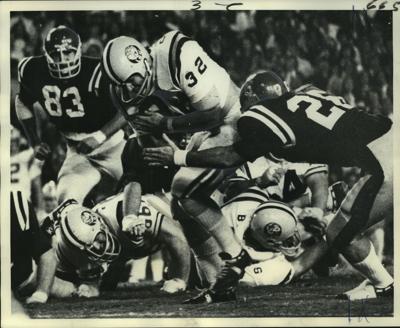Like so many football fans living in Louisiana or Mississippi in the early 1970s, Jim Thompson Jr. remembers exactly where he was the evening of Nov. 4, 1972.
He was a senior from Vicksburg, Mississippi, at the time. Instead of going to the game in Baton Rouge, he attended a party at his school in a field with a bonfire and listened to it on the radio.

Here’s what Thompson and so many across the South heard from LSU play-by-play broadcaster John Ferguson on that night:
“Interference against Ole Miss with four seconds to play. And so, time for one play in the game … four seconds to go in the game.”
One play to go — at least that’s what all the fans for LSU and Ole Miss, not to mention the players, thought at the time anyway.
“Interference against the Ole Miss Rebels at the 10, and it’s first down and about goal to go for the Tigers,” Ferguson said, continuing to set the stage for the dramatic finish. “But all of that means nothing unless the Tigers can get the football in the end zone on this play. A big season rides on this play and the right arm of Bert Jones.”
While Ole Miss fans were about to yell in rage, Ferguson doesn’t miss a beat.
“He’s back to throw, shoots to Ledoux and it’s incomplete in the end zone, with one second left to go. One second to go. The pass was broken up … in the end zone, and twice the Tigers have gone to (Jimmy) Ledoux in the end zone. And still no marbles.”
While everyone stood in stunned amazement that LSU actually had one more second on the clock after running the play, Ferguson just kept going.
“One second to play and so time will run out on the next one,” Ferguson said. “Al Coffee is coming into the game in place of Ledoux. Here is the game over, Jones back to throw, looking for a receiver. He has Davis and it is good on the last play of the game, Brad Davis on a Bert Jones pass in the corner of the end zone.”
Thompson and all the LSU fans everywhere leaped for joy over the 17-16 victory, while Ole Miss fans were convinced there was no way the Tigers could get off two plays in four seconds.
The headline the next day in Jackson, Mississippi, read, “Ole Miss-16, LSU-10 +7.”
When LSU beat Ole Miss 51-14 the following season, the headline in Baton Rouge read, "Ole Miss-14, LSU-7 +7+7+7+7+7 …”
Fifty years later, the controversial play is still discussed.
After all this time, however, Thompson wonders how accurate the legendary aftermath of that game really is.
As the story goes, some angry Ole Miss fans posted a sign, “You are now entering Louisiana, set your clocks back 4 seconds.”
So Thompson’s question now is, did such a sign ever really exist?
“I never saw the actual sign, but I definitely saw a picture of the sign,” Concordia Sentinel sports editor Joey Martin said.
Like Thompson, Martin was listening to the game on the radio.
“I wasn’t at the game, but we were in our beds listening to it and jumping up and down,” Martin said.
Since then, Martin has interviewed many on both sides of the LSU-Ole Miss rivalry.
Martin describes the sign as "makeshift."
“But it was a good size sign," he said.
Martin’s guess was that it was near Woodville, Mississippi. Others have said it was near Natchez, Mississippi.
“I don’t believe it was around Natchez,” Martin said. “There were just as many LSU fans in Natchez because it’s so much closer to Baton Rouge than it is to Ole Miss."
Theoretically, different signs could have been in different communities.
Tom Graning, the son of longtime SEC football official Al Graning, said he saw it hanging from an overpass near McComb.
Martin added, “Sports Illustrated had a tidbits section and they had a picture of it in that section.”
Like many LSU fans at the time, Martin just had fun with their counterparts.
“The Ole Miss fans were mad,” he joked. “I kept telling people, ‘That Bert Jones had a rifle, you know.’ ”
Jones himself later laughed in interviews looking back at the game that he apparently had a quicker release than people thought at the time.
We’re on a mission to answer the things about this state that have you stumped. Send us your question, your name, email address, phone number and town via this form or in an email to curiouslouisiana@theadvocate.com.
Read more stories from Curious Louisiana:
How did second-lines start in New Orleans? Here’s the history behind their name and origins.




